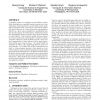508 search results - page 69 / 102 » A graphical model for protein secondary structure prediction |
RECOMB
2003
Springer
14 years 9 months ago
2003
Springer
We describe a novel method for detecting the domain structure of a protein from sequence information alone. The method is based on analyzing multiple sequence alignments that are ...
RECOMB
2007
Springer
14 years 9 months ago
2007
Springer
Transcription factor (TF) binding to its DNA target site is a fundamental regulatory interaction. The most common model used to represent TF binding specificities is a position spe...
BMCBI
2008
13 years 9 months ago
2008
Background: The structure of many eukaryotic cell regulatory proteins is highly modular. They are assembled from globular domains, segments of natively disordered polypeptides and...
KDD
2007
ACM
14 years 9 months ago
2007
ACM
The need for mining causality, beyond mere statistical correlations, for real world problems has been recognized widely. Many of these applications naturally involve temporal data...
ATAL
2010
Springer
13 years 10 months ago
2010
Springer
A dynamic model of a multiagent system defines a probability distribution over possible system behaviors over time. Alternative representations for such models present tradeoffs i...

